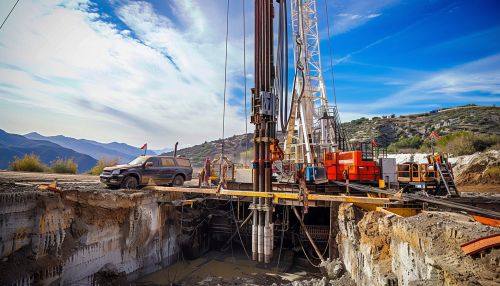Deep drilling
Introduction
Deep drilling is a process that involves the creation of deep holes in the earth's crust for various purposes, such as the extraction of natural resources, scientific research, and geothermal energy production. It is a specialized field that requires a deep understanding of geology, engineering, and drilling technology. Deep drilling is often associated with the oil and gas industry, but it is also used in other sectors, such as mining and geothermal energy production.
History
The history of deep drilling dates back to ancient times when humans first started to drill holes in the ground to extract water and other resources. The earliest known deep drilling operations were carried out in China around 2000 BC, where wells were drilled to depths of up to 800 meters using bamboo poles and primitive drilling tools. The development of modern deep drilling techniques began in the 19th century with the advent of the industrial revolution. The first successful oil well was drilled by Edwin Drake in Pennsylvania in 1859, marking the beginning of the modern oil industry. Since then, drilling technology has evolved significantly, with modern drilling rigs capable of reaching depths of over 10,000 meters.
Drilling Techniques
There are several techniques used in deep drilling, each with its own advantages and disadvantages. The choice of drilling method depends on the nature of the project, the type of rock being drilled, and the depth of the hole.
Rotary Drilling
Rotary drilling is the most common method used in deep drilling. It involves the use of a rotating drill bit to cut through the rock. The drill bit is attached to a drill pipe, which is rotated by a top drive or rotary table on the drilling rig. As the drill bit cuts through the rock, a drilling fluid, or mud, is pumped down the drill pipe and back up the hole to remove the cuttings and cool the drill bit.
Percussion Drilling
Percussion drilling, also known as cable tool drilling, is an older method of drilling that involves repeatedly lifting and dropping a heavy drill bit into the hole to break up the rock. This method is slower than rotary drilling but can be more effective in certain types of rock.
Directional Drilling
Directional drilling is a technique used to drill wells that deviate from a vertical path. This technique is often used in offshore drilling to reach oil and gas reservoirs under the seabed, and in geothermal drilling to access heat sources in the earth's crust.
Drilling Equipment
Deep drilling operations require a range of specialized equipment, including drilling rigs, drill bits, drill pipes, and drilling fluids.
Drilling Rigs
A drilling rig is a machine that creates holes in the earth's crust. Drilling rigs come in a variety of sizes and configurations, depending on the nature of the drilling project. The main components of a drilling rig include the derrick, the drawworks, the rotary table or top drive, and the mud pumps.
Drill Bits
The drill bit is the tool used to cut through the rock. Drill bits come in a variety of types and sizes, depending on the nature of the rock being drilled. The most common types of drill bits used in deep drilling are roller cone bits and fixed cutter bits.
Drill Pipes
The drill pipe is a hollow tube that connects the drill bit to the drilling rig. The drill pipe is used to transmit rotational force from the rig to the drill bit, and to circulate drilling fluid down the hole.
Drilling Fluids
Drilling fluid, also known as drilling mud, is a mixture of water, clay, and other additives that is used to cool the drill bit, carry cuttings out of the hole, and maintain pressure in the well.
Applications
Deep drilling is used in a variety of applications, including oil and gas extraction, mining, geothermal energy production, and scientific research.
Oil and Gas Extraction
The primary application of deep drilling is in the oil and gas industry, where it is used to drill wells to extract oil and gas from underground reservoirs.
Mining
Deep drilling is also used in the mining industry to extract minerals and other resources from deep underground.
Geothermal Energy Production
In the field of geothermal energy production, deep drilling is used to access heat sources in the earth's crust.
Scientific Research
Deep drilling is also used in scientific research to study the earth's crust and to understand the processes that shape our planet.
Challenges and Future Trends
Deep drilling presents a number of challenges, including the high cost of drilling operations, the technical difficulties of drilling to great depths, and the environmental impact of drilling activities. Despite these challenges, the demand for deep drilling is expected to increase in the future, driven by the growing demand for energy and the depletion of shallow oil and gas reserves.
See Also


